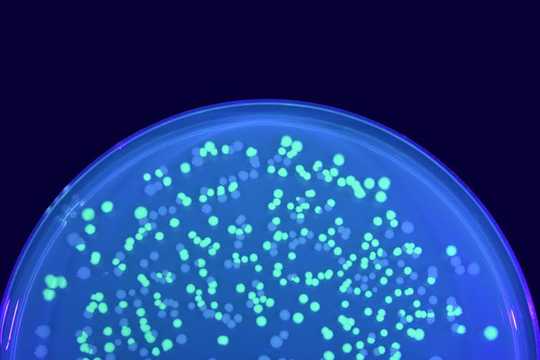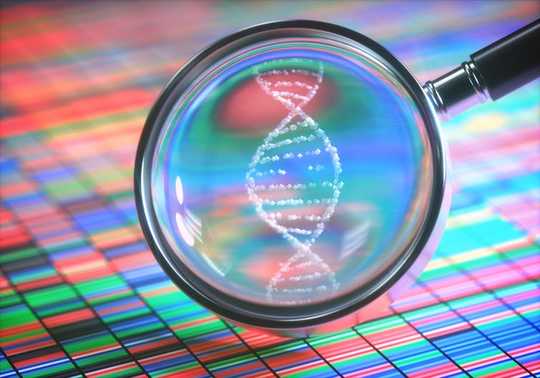Rarely has our environment changed so quickly. On top of climate change, we’re exposing ourselves to air pollutants, microplastics and unprecedented levels of fat, salt and sugar in our food.
Environmental change is one of the things that can produce big, serious mutations in our DNA that can quickly lead to disease, such as cancer caused by radiation. But our DNA also contains many tiny hidden mutations. While they initially have no effect on us thanks to a box of genetic tricks our bodies use to protect us, these “cryptic” variations can build up over many generations and then be brought to life by big environmental changes.
Recent research has shown just how important these cryptic variations are to evolution. There’s a chance they could be behind the growing risk of problems such as diabetes, cancer and heart disease, and could even produce new diseases. But these mutations could also be hidden gifts from our ancestors that enable us to adapt more quickly to the issues we face, from medical conditions to climate change.
Changes to DNA combined with the process of natural selection are what allow species to evolve. Some genetic variations provide a selective advantage and the individuals who have them are more likely to survive and pass on their genes, gradually spreading them throughout the species. Any changes that are a disadvantage reduce the survival or reproductive chances for an individual and are less likely to be passed to future generations.
Buffer against change
Cryptic genetic variation gives us a third alternative. Some changes in DNA have little or no effect, giving neither an advantage or disadvantage but slowly building up over generations. These variations hide in various ways. For example, simple organisms are able to reduce the impact of changes in the environment on their biological functions using a process known as canalisation. This means minor changes to their DNA don’t cause visible differences.
Sometimes, genes are even duplicated in different parts of the DNA, so that there is redundancy in the system. Any changes in one gene can then be hidden by the others.
In complex lifeforms, many new variations also go unseen because we have two versions of most of our genes (one from mum and one from dad), and one of the versions is dominant over the other. Cryptic genetic variations are recessive (not dominant) in this relationship and so under normal conditions do not show.
There are also some very minor changes that don’t cause any real change to the biochemistry of the organism. They perhaps swap one component in a protein for something very similar.
All these things act as a buffer against physical changes, allowing a build-up of variation in the DNA that only becomes visible when there is a significant change in the environment. Many researchers in the field of evolutionary genetics believe that this cryptic genetic variation may answer the problem of how species have been able to rapidly adapt to new challenges in the past. The finches of the Galapagos islands helped Darwin to develop his theory of evolution, and the rapid creation of the different types of finches he saw is very likely to be an example of cryptic variation at work.
 Illuminating experiment: fluorescent green E. coli bacteria. KPWangkanont/Shutterstock
Illuminating experiment: fluorescent green E. coli bacteria. KPWangkanont/Shutterstock
Observing this change in animals or in the wild is impossible, given the multi-generational timescales involved. But researchers at the University of Zürich recently used E. coli bacteria to prove the importance of this variation in evolution and adaptation to new environments.
In their experiments, they created an artificial environment in which bacteria that could produce green fluorescence had an advantage over those that produced yellow. The researchers showed that bacterial colonies containing higher levels of cryptic variation were able to switch more rapidly to fluorescing green.
This was a tiny, insignificant change for the bacteria, but a very clear proof of the concept that cryptic variation can help a species adapt more quickly to environmental change. This may be very important in understanding the importance of cryptic variation in more critical systems affecting disease resistance and susceptibility.
Researchers at the University of Würzburg have shown that the level of cryptic genetic variation in Neisseria meningitidis, a bacterium that can cause meningitis, contributes to how harmful the resulting disease is. This higher level of variation is only a factor when the bacteria enter the bloodstream, but has no impact in their normal environment of the human throat.
A better understanding of how these bacteria change when they’re in the blood may help us to combat diseases such as meningitis. We will have a better understanding of how the symptoms occur and, crucially, could be able to tackle any antibiotic resistance hidden away in the bacteria’s DNA.
Hidden potential
Our own DNA also harbours high levels of cryptic variation. The potential for cryptic genetic variants hidden away in our DNA suddenly becoming not so cryptic thanks to changes in the environment is a serious concern.
Though we still don’t understand the exact effects of cryptic variation, several changes in our DNA, silently inherited from our ancestors, have already been linked to increased risk of diseases such as asthma or cancer. For people with these changes, exposure to car exhaust fumes, is more likely to have an effect.
However, there may also be solutions as well as problems hidden in DNA. As the world warms as a result of climate change, could cryptic genetic variation give us and other species a much-needed lifeline? The increased ability to evolve quickly and adapt, may be all that stands between a species surviving global warming and extinction.![]()
About The Author
Michael J Porter, Lecturer in Molecular Genetics, University of Central Lancashire
This article is republished from The Conversation under a Creative Commons license. Read the original article.
Related Books:
The Body Keeps the Score: Brain Mind and Body in the Healing of Trauma
by Bessel van der Kolk
This book explores the connections between trauma and physical and mental health, offering insights and strategies for healing and recovery.
Click for more info or to order
Breath: The New Science of a Lost Art
by James Nestor
This book explores the science and practice of breathing, offering insights and techniques for improving physical and mental health.
Click for more info or to order
The Plant Paradox: The Hidden Dangers in "Healthy" Foods That Cause Disease and Weight Gain
by Steven R. Gundry
This book explores the links between diet, health, and disease, offering insights and strategies for improving overall health and wellness.
Click for more info or to order
The Immunity Code: The New Paradigm for Real Health and Radical Anti-Aging
by Joel Greene
This book offers a new perspective on health and immunity, drawing on principles of epigenetics and offering insights and strategies for optimizing health and aging.
Click for more info or to order
The Complete Guide to Fasting: Heal Your Body Through Intermittent, Alternate-Day, and Extended Fasting
by Dr. Jason Fung and Jimmy Moore
This book explores the science and practice of fasting offering insights and strategies for improving overall health and wellness.


























